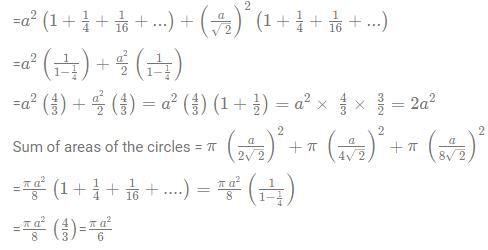Diagnostic Test: CAT - 1 - CAT MCQ
30 Questions MCQ Test - Diagnostic Test: CAT - 1
Read the passage carefully and answer the following questions:
Mythology remains important in Western culture. Take, for instance, the role model of the hero, of contemporary revolutionaries, martyrs and dictators. These ideal figures exemplify models of human achievement. Similarly, notions of salvation, progress and ethics are so constitutive of our notions of reality that they’re often communicated through the format of mythology. There’s a surfeit of cultural products that fulfil the function of myth whereby characters and stories give us the means to understand the world we live in. Through superhero comic books, to the obscure immanence of modern art, from visions of paradisiacal vacations, to computer games and the self-mythologising of social media production, we seek a higher ground beyond the banal and the profane. We’ve even replaced the effervescent experience of sacred rites...in our engagement with art, drugs, cinema, rock music and all-night dance parties. Lastly, individuals have developed their own ways to create self-narratives that include mythical transitions in pilgrimages or personal quests to their ancestral lands. Likewise, some seek inner spaces wherein faith and meaning can be transformed into experience.
To prepare for our exploration of contemporary mythology, we can look back at civilisations and consider the function of the stories they told. The story of the flood, for example, recurs in early urban societies, marking a crisis in human-divine relations and man’s experience of gradual self-reliance and separation from nature. Whereas during the Axial Age (800-200 BCE), faith developed in an environment of early trade economies, at which time we observe a concern with individual conscience, morality, compassion and a tendency to look within. According to Karen Armstrong’s A Short History of Myth (2005), these Axial myths of interiority indicate that people felt they no longer shared the same nature as the gods, and that the supreme reality had become impossibly difficult to access. These myths were a response to the loss of previous notions of social order, cosmology and human good, and represented ways to portray these social transformations in macrocosmic stories, and were reflections of how people tried to make sense of their rapidly changing world.
What constitutes a mythology? It’s an organised canon of beliefs that explains the state of the world. It also delivers an origin story - such as the Hindu Laws of Manu or the Biblical creation story - that creates a setting for how we experience the world. In fact, for Eliade, all myths provided an explanation of the world by virtue of giving an account of where things came from. If all mythologies are origin stories in this sense, what are the origin stories suggested by psychology? Two original elements of human nature are explained in its lore: the story of personhood - that is, what it means to be an individual and have an identity - and, secondly, the story of our physical constitution in the brain.
Contemporary psychology is a form of mythology insofar as it is an attempt to succor our need to believe in stories that provide a sense of value and signification in the context of secular modernity. The ways in which psychology is used - for example in experiments or self-help literature or personality tests or brain scans - are means of providing rituals to enact the myths of personhood and materialism.
Q. Why does the author refer to contemporary psychology as a form of mythology?
Read the passage carefully and answer the following questions:
Mythology remains important in Western culture. Take, for instance, the role model of the hero, of contemporary revolutionaries, martyrs and dictators. These ideal figures exemplify models of human achievement. Similarly, notions of salvation, progress and ethics are so constitutive of our notions of reality that they’re often communicated through the format of mythology. There’s a surfeit of cultural products that fulfil the function of myth whereby characters and stories give us the means to understand the world we live in. Through superhero comic books, to the obscure immanence of modern art, from visions of paradisiacal vacations, to computer games and the self-mythologising of social media production, we seek a higher ground beyond the banal and the profane. We’ve even replaced the effervescent experience of sacred rites...in our engagement with art, drugs, cinema, rock music and all-night dance parties. Lastly, individuals have developed their own ways to create self-narratives that include mythical transitions in pilgrimages or personal quests to their ancestral lands. Likewise, some seek inner spaces wherein faith and meaning can be transformed into experience.
To prepare for our exploration of contemporary mythology, we can look back at civilisations and consider the function of the stories they told. The story of the flood, for example, recurs in early urban societies, marking a crisis in human-divine relations and man’s experience of gradual self-reliance and separation from nature. Whereas during the Axial Age (800-200 BCE), faith developed in an environment of early trade economies, at which time we observe a concern with individual conscience, morality, compassion and a tendency to look within. According to Karen Armstrong’s A Short History of Myth (2005), these Axial myths of interiority indicate that people felt they no longer shared the same nature as the gods, and that the supreme reality had become impossibly difficult to access. These myths were a response to the loss of previous notions of social order, cosmology and human good, and represented ways to portray these social transformations in macrocosmic stories, and were reflections of how people tried to make sense of their rapidly changing world.
What constitutes a mythology? It’s an organised canon of beliefs that explains the state of the world. It also delivers an origin story - such as the Hindu Laws of Manu or the Biblical creation story - that creates a setting for how we experience the world. In fact, for Eliade, all myths provided an explanation of the world by virtue of giving an account of where things came from. If all mythologies are origin stories in this sense, what are the origin stories suggested by psychology? Two original elements of human nature are explained in its lore: the story of personhood - that is, what it means to be an individual and have an identity - and, secondly, the story of our physical constitution in the brain.
Contemporary psychology is a form of mythology insofar as it is an attempt to succor our need to believe in stories that provide a sense of value and signification in the context of secular modernity. The ways in which psychology is used - for example in experiments or self-help literature or personality tests or brain scans - are means of providing rituals to enact the myths of personhood and materialism.
Q. Which of the following statements about mythology cannot be inferred from the passage?
DIRECTIONS for the question: The four sentences (labelled 1, 2, 3, 4) below, when properly sequenced, would yield a coherent paragraph. Decide on the proper sequencing of the order of the sentences and key in the sequence as your answer:
- And, to say that someone is or is not intelligent has never been merely a comment on their mental faculties.
- But the notion that intelligence could determine one’s station in life was already much older.
- The idea that intelligence could be quantified, like blood pressure or shoe size, was barely a century old when I took the test that would decide my place in the world.
- It is always also a judgment on what they are permitted to do.
Read the passage carefully and answer the following questions:
Charles Darwin thought the mental capacities of animals and people differed only in degree, not kind—a natural conclusion to reach when armed with the radical new belief that the one evolved from the other. His last great book, “The Expression of Emotions in Man and Animals”, examined joy, love and grief in birds, domestic animals and primates as well as in various human races. But Darwin’s attitude to animals—easily shared by people in everyday contact with dogs, horses, even mice—ran contrary to a long tradition in European thought which held that animals had no minds at all. This way of thinking stemmed from the argument of René Descartes, a great 17th-century philosopher, that people were creatures of reason, linked to the mind of God, while animals were merely machines made of flesh—living robots which, in the words of Nicolas Malebranche, one of his followers, “eat without pleasure, cry without pain, grow without knowing it: they desire nothing, fear nothing, know nothing.”
For much of the 20th century biology cleaved closer to Descartes than to Darwin. Students of animal behaviour did not rule out the possibility that animals had minds but thought the question almost irrelevant since it was impossible to answer. One could study an organism’s inputs (such as food or the environment) or outputs (its behaviour). But the organism itself remained a black box: unobservable things such as emotions or thoughts were beyond the scope of objective inquiry.
In the past 40 years, however, a wide range of work both in the field and the lab has pushed the consensus away from strict behaviourism and towards that Darwin-friendly view. Progress has not been easy or quick; as the behaviourists warned, both sorts of evidence can be misleading. Laboratory tests can be rigorous, but are inevitably based on animals which may not behave as they do in the wild. Field observations can be dismissed as anecdotal. Running them for years or decades and on a large scale goes some way to guarding against that problem, but such studies are rare.
Nevertheless, most scientists...say with confidence that some animals process information and express emotions in ways that are accompanied by conscious mental experience. They agree that animals...have complex mental capacities; that a few species have attributes once thought to be unique to people, such as the ability to give objects names and use tools; and that a handful of animals—primates, corvids (the crow family) and cetaceans (whales and dolphins)— have something close to what in humans is seen as culture, in that they develop distinctive ways of doing things which are passed down by imitation and example. Dolphins have been found to imitate the behaviour of other dolphins, in their group. No animals have all the attributes of human minds; but almost all the attributes of human minds are found in some animal or other.
Brain mapping reveals that the neurological processes underlying what look like emotions in rats are similar to those behind what clearly are emotions in humans. As a group of neuroscientists seeking to sum the field up put it in 2012, “Humans are not unique in possessing the neurological substrates that generate consciousness. Non-human animals, including all mammals and birds, and many other creatures...also possess these neurological substrates.”
Q. For much of the 20th century, students of animal behaviour opined that
DIRECTIONS for the question: Five sentences related to a topic are given below. Four of them can be put together to form a meaningful and coherent short paragraph. Identify the odd one out.
- The band consists of vocalist Anthony Kiedis, bassist Flea, drummer Chad Smith, and guitarist John Frusciante.
- Their music incorporates elements of alternative rock, funk, punk rock and psychedelic rock.
- Alternative rock is a category of rock music that emerged from the independent music underground of the 1970s and became widely popular in the 1990s.
- The Red Hot Chili Peppers are an American rock band formed in Los Angeles in 1983, and with over 80 million records sold worldwide, the Red Hot Chili Peppers are one of the best-selling bands of all time.
- They have won six Grammy Awards, and in 2012 were inducted into the Rock and Roll Hall of Fame.
The passage given below is followed by four summaries. Choose the option that best captures the author’s position.
Auctions use the principle of scarcity, whereby we overvalue things that we think might run out. Auction items are scarce in that they are unique (only one person can have them), and scarce in time (after the bids are finished, you’ve lost your chance). Think how many shop sales successfully rely on scarcity heuristics such as “Last day of sale!”, or “Only 2 left in stock!”, and you’ll get a feel for how powerful this persuasion principle can be. The other principle used by auctions is that of “social proof”. We all tend to take the lead from other people; if everybody does something, or says something, most of us join in before we think about what we really should do. Auctions put you in intimate contact with other people who are all providing social proof that the sale item is important and valuable.
Read the passage carefully and answer the following questions:
Charles Darwin thought the mental capacities of animals and people differed only in degree, not kind—a natural conclusion to reach when armed with the radical new belief that the one evolved from the other. His last great book, “The Expression of Emotions in Man and Animals”, examined joy, love and grief in birds, domestic animals and primates as well as in various human races. But Darwin’s attitude to animals—easily shared by people in everyday contact with dogs, horses, even mice—ran contrary to a long tradition in European thought which held that animals had no minds at all. This way of thinking stemmed from the argument of René Descartes, a great 17th-century philosopher, that people were creatures of reason, linked to the mind of God, while animals were merely machines made of flesh—living robots which, in the words of Nicolas Malebranche, one of his followers, “eat without pleasure, cry without pain, grow without knowing it: they desire nothing, fear nothing, know nothing.”
For much of the 20th century biology cleaved closer to Descartes than to Darwin. Students of animal behaviour did not rule out the possibility that animals had minds but thought the question almost irrelevant since it was impossible to answer. One could study an organism’s inputs (such as food or the environment) or outputs (its behaviour). But the organism itself remained a black box: unobservable things such as emotions or thoughts were beyond the scope of objective inquiry.
In the past 40 years, however, a wide range of work both in the field and the lab has pushed the consensus away from strict behaviourism and towards that Darwin-friendly view. Progress has not been easy or quick; as the behaviourists warned, both sorts of evidence can be misleading. Laboratory tests can be rigorous, but are inevitably based on animals which may not behave as they do in the wild. Field observations can be dismissed as anecdotal. Running them for years or decades and on a large scale goes some way to guarding against that problem, but such studies are rare.
Nevertheless, most scientists...say with confidence that some animals process information and express emotions in ways that are accompanied by conscious mental experience. They agree that animals...have complex mental capacities; that a few species have attributes once thought to be unique to people, such as the ability to give objects names and use tools; and that a handful of animals—primates, corvids (the crow family) and cetaceans (whales and dolphins)— have something close to what in humans is seen as culture, in that they develop distinctive ways of doing things which are passed down by imitation and example. Dolphins have been found to imitate the behaviour of other dolphins, in their group. No animals have all the attributes of human minds; but almost all the attributes of human minds are found in some animal or other.
Brain mapping reveals that the neurological processes underlying what look like emotions in rats are similar to those behind what clearly are emotions in humans. As a group of neuroscientists seeking to sum the field up put it in 2012, “Humans are not unique in possessing the neurological substrates that generate consciousness. Non-human animals, including all mammals and birds, and many other creatures...also possess these neurological substrates.”
Q. Which of the following views of Descartes and/or his followers cannot be inferred from the passage?
Read the passage carefully and answer the following questions:
Mythology remains important in Western culture. Take, for instance, the role model of the hero, of contemporary revolutionaries, martyrs and dictators. These ideal figures exemplify models of human achievement. Similarly, notions of salvation, progress and ethics are so constitutive of our notions of reality that they’re often communicated through the format of mythology. There’s a surfeit of cultural products that fulfil the function of myth whereby characters and stories give us the means to understand the world we live in. Through superhero comic books, to the obscure immanence of modern art, from visions of paradisiacal vacations, to computer games and the self-mythologising of social media production, we seek a higher ground beyond the banal and the profane. We’ve even replaced the effervescent experience of sacred rites...in our engagement with art, drugs, cinema, rock music and all-night dance parties. Lastly, individuals have developed their own ways to create self-narratives that include mythical transitions in pilgrimages or personal quests to their ancestral lands. Likewise, some seek inner spaces wherein faith and meaning can be transformed into experience.
To prepare for our exploration of contemporary mythology, we can look back at civilisations and consider the function of the stories they told. The story of the flood, for example, recurs in early urban societies, marking a crisis in human-divine relations and man’s experience of gradual self-reliance and separation from nature. Whereas during the Axial Age (800-200 BCE), faith developed in an environment of early trade economies, at which time we observe a concern with individual conscience, morality, compassion and a tendency to look within. According to Karen Armstrong’s A Short History of Myth (2005), these Axial myths of interiority indicate that people felt they no longer shared the same nature as the gods, and that the supreme reality had become impossibly difficult to access. These myths were a response to the loss of previous notions of social order, cosmology and human good, and represented ways to portray these social transformations in macrocosmic stories, and were reflections of how people tried to make sense of their rapidly changing world.
What constitutes a mythology? It’s an organised canon of beliefs that explains the state of the world. It also delivers an origin story - such as the Hindu Laws of Manu or the Biblical creation story - that creates a setting for how we experience the world. In fact, for Eliade, all myths provided an explanation of the world by virtue of giving an account of where things came from. If all mythologies are origin stories in this sense, what are the origin stories suggested by psychology? Two original elements of human nature are explained in its lore: the story of personhood - that is, what it means to be an individual and have an identity - and, secondly, the story of our physical constitution in the brain.
Contemporary psychology is a form of mythology insofar as it is an attempt to succor our need to believe in stories that provide a sense of value and signification in the context of secular modernity. The ways in which psychology is used - for example in experiments or self-help literature or personality tests or brain scans - are means of providing rituals to enact the myths of personhood and materialism.
Q. Which of the following statements about human behaviour cannot be inferred from the first paragraph?
DIRECTIONS for the question: The four sentences (labelled 1, 2, 3, 4) below, when properly sequenced, would yield a coherent paragraph. Decide on the proper sequencing of the order of the sentences and key in the sequence as your answer:
- Now, tech giants like Facebook and Twitter are actively copying Clubhouse.
- Its growth is undeniable thanks to figures as disparate as Oprah Winfrey, Elon Musk and, Trump consigliere Roger Stone — not to mention regular people craving conversation after nearly a year of lockdown.
- Now, with more than two million users and the app on the precipice of the mainstream, Clubhouse has become a flashpoint in the broader culture wars around censorship, online harassment, and the far-reaching powers of Big Tech.
- They are doling out the new talking features for their billions of users, giving a preview of what the future of online life is likely to look like.
Read the passage carefully and answer the following questions:
Charles Darwin thought the mental capacities of animals and people differed only in degree, not kind—a natural conclusion to reach when armed with the radical new belief that the one evolved from the other. His last great book, “The Expression of Emotions in Man and Animals”, examined joy, love and grief in birds, domestic animals and primates as well as in various human races. But Darwin’s attitude to animals—easily shared by people in everyday contact with dogs, horses, even mice—ran contrary to a long tradition in European thought which held that animals had no minds at all. This way of thinking stemmed from the argument of René Descartes, a great 17th-century philosopher, that people were creatures of reason, linked to the mind of God, while animals were merely machines made of flesh—living robots which, in the words of Nicolas Malebranche, one of his followers, “eat without pleasure, cry without pain, grow without knowing it: they desire nothing, fear nothing, know nothing.”
For much of the 20th century biology cleaved closer to Descartes than to Darwin. Students of animal behaviour did not rule out the possibility that animals had minds but thought the question almost irrelevant since it was impossible to answer. One could study an organism’s inputs (such as food or the environment) or outputs (its behaviour). But the organism itself remained a black box: unobservable things such as emotions or thoughts were beyond the scope of objective inquiry.
In the past 40 years, however, a wide range of work both in the field and the lab has pushed the consensus away from strict behaviourism and towards that Darwin-friendly view. Progress has not been easy or quick; as the behaviourists warned, both sorts of evidence can be misleading. Laboratory tests can be rigorous, but are inevitably based on animals which may not behave as they do in the wild. Field observations can be dismissed as anecdotal. Running them for years or decades and on a large scale goes some way to guarding against that problem, but such studies are rare.
Nevertheless, most scientists...say with confidence that some animals process information and express emotions in ways that are accompanied by conscious mental experience. They agree that animals...have complex mental capacities; that a few species have attributes once thought to be unique to people, such as the ability to give objects names and use tools; and that a handful of animals—primates, corvids (the crow family) and cetaceans (whales and dolphins)— have something close to what in humans is seen as culture, in that they develop distinctive ways of doing things which are passed down by imitation and example. Dolphins have been found to imitate the behaviour of other dolphins, in their group. No animals have all the attributes of human minds; but almost all the attributes of human minds are found in some animal or other.
Brain mapping reveals that the neurological processes underlying what look like emotions in rats are similar to those behind what clearly are emotions in humans. As a group of neuroscientists seeking to sum the field up put it in 2012, “Humans are not unique in possessing the neurological substrates that generate consciousness. Non-human animals, including all mammals and birds, and many other creatures...also possess these neurological substrates.”
Q. Which of the following statements can be inferred from the passage?
I. There is now a consensus among most scientists that some animals exhibit most of the attributes characteristic of human minds.
II. Some animals are self-aware and are also conscious of their social milieu.
III. Some animal minds are capable of imitative behaviour.
IV. People who rarely came in contact with animals disregarded Darwin's views on animal minds.
Read the passage carefully and answer the following questions:
Mythology remains important in Western culture. Take, for instance, the role model of the hero, of contemporary revolutionaries, martyrs and dictators. These ideal figures exemplify models of human achievement. Similarly, notions of salvation, progress and ethics are so constitutive of our notions of reality that they’re often communicated through the format of mythology. There’s a surfeit of cultural products that fulfil the function of myth whereby characters and stories give us the means to understand the world we live in. Through superhero comic books, to the obscure immanence of modern art, from visions of paradisiacal vacations, to computer games and the self-mythologising of social media production, we seek a higher ground beyond the banal and the profane. We’ve even replaced the effervescent experience of sacred rites...in our engagement with art, drugs, cinema, rock music and all-night dance parties. Lastly, individuals have developed their own ways to create self-narratives that include mythical transitions in pilgrimages or personal quests to their ancestral lands. Likewise, some seek inner spaces wherein faith and meaning can be transformed into experience.
To prepare for our exploration of contemporary mythology, we can look back at civilisations and consider the function of the stories they told. The story of the flood, for example, recurs in early urban societies, marking a crisis in human-divine relations and man’s experience of gradual self-reliance and separation from nature. Whereas during the Axial Age (800-200 BCE), faith developed in an environment of early trade economies, at which time we observe a concern with individual conscience, morality, compassion and a tendency to look within. According to Karen Armstrong’s A Short History of Myth (2005), these Axial myths of interiority indicate that people felt they no longer shared the same nature as the gods, and that the supreme reality had become impossibly difficult to access. These myths were a response to the loss of previous notions of social order, cosmology and human good, and represented ways to portray these social transformations in macrocosmic stories, and were reflections of how people tried to make sense of their rapidly changing world.
What constitutes a mythology? It’s an organised canon of beliefs that explains the state of the world. It also delivers an origin story - such as the Hindu Laws of Manu or the Biblical creation story - that creates a setting for how we experience the world. In fact, for Eliade, all myths provided an explanation of the world by virtue of giving an account of where things came from. If all mythologies are origin stories in this sense, what are the origin stories suggested by psychology? Two original elements of human nature are explained in its lore: the story of personhood - that is, what it means to be an individual and have an identity - and, secondly, the story of our physical constitution in the brain.
Contemporary psychology is a form of mythology insofar as it is an attempt to succor our need to believe in stories that provide a sense of value and signification in the context of secular modernity. The ways in which psychology is used - for example in experiments or self-help literature or personality tests or brain scans - are means of providing rituals to enact the myths of personhood and materialism.
Q. The author cites the examples of the story of the flood and myth of interiority to drive home the point that
The software development team of Cracku has come up with a new spreadsheet viewing and editing application. The rows are denoted by alphabet(s) starting with A, B, C,..., Z, followed by AA, AB,..., AZ, BA,..., ZZ, followed by AAA, AAB,..... and so on. The columns are denoted in the same way. A cell, which is an intersection of a row and column is denoted by the alphabet(s) representing the row followed by '#' followed by the alphabet(s) representing the column.
For example, the cell at the intersection of the 27th row and 8th column is denoted by AA#H.
Based on the information given above, answer the questions that follow.
If there is a total of 65536 cells in a spreadsheet, such that the sum of the number of rows and the number of columns is the least possible, what is the sequence of characters denoting the last cell of the sheet? The last cell is the cell at the intersection of the last row and the last column.
There are 4 properties available for rent in the city of Hyderabad. They are in 4 different locations among Kondapur, Madhapur, Whitefield and Gachibowli. The rents of the 4 properties are 20000 Rs/month, 24000 Rs/month, 28000 Rs/month and 30000 Rs/month in no particular order. The security deposits of the 4 properties are 1 month equivalent of rent, 2 months equivalent of rent, 3 months equivalent of rent and 4 months equivalent of rent, in no particular order. Also, there are 4 different brokers A, B, C, D who have the responsibility to rent these 4 properties. Brokers belong to 3 categories, truth-tellers, who always tell the truth, liars who always lie and alternators, who alternate between truth and a lie. It is also known that at least one of the brokers is a truth-teller. Also, each of them says 3 statements each, recorded as follows:
A:
1. The highest amount of rent is for the Gachibowli property.
2. The lowest amount of rent is not for the Kondapur property.
3. The broker, D sometimes lies.
B:
1. The Kondapur property has a deposit equivalent to 4 months of rent.
2. The broker, C never speaks the truth.
3. The rent of Whitefield is 24000 Rs/month.
C:
1. The rent of the Whitefield property(in Rs) when divided by 1000 has 8 distinct factors.
2. The broker, A never speaks the truth.
3. The monthly rent of the Whitefield property is neither the highest nor the lowest.
D:
1. The average of all rents is 25500 Rs/month.
2. The broker, A is not an alternator.
3. The Madhapur property has a deposit equivalent to 3 months of rent.
Based on the information given above, answer the questions that follow.
Q. Which of the following is a correct match?
A well known FMCG company mainly deals in manufacturing and selling its product in 4 different sectors which are namely, Packaged Foods, Electronics, Garments and Home Appliances. The percentage contribution to the sales they had to the year 2018, 2019 and 2020 are given as follows
Sales
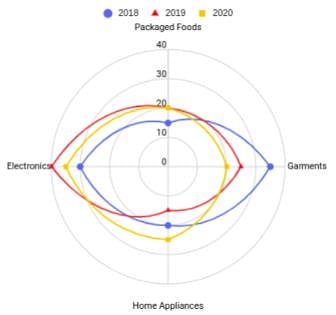
Furthermore, the profit % obtained by selling the items of a particular sector year on year is given as follows
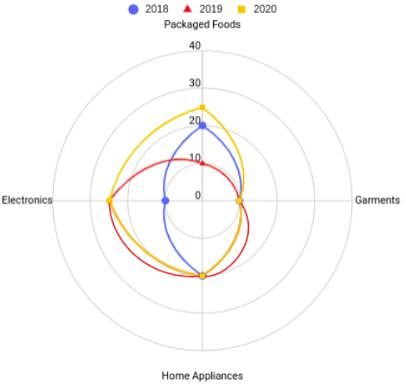
Based on the above data, answer the following questions
Q. If it is known that the total cost incurred for producing Goods was the same for the year 2019 and 2020. Then what is the approximate percentage change in sales of the company from the year 2019 to 2020?
A market surveyor was tasked to get basic information on 5 panellists who were sitting in a row. The leftmost position was numbered 1 and the rightmost was numbered 5. The details required were name, native city, current city and the car they owned. To capture the details she made a table. There were 4 interns under her and she wanted the interns to get first-hand experience of market survey, hence she sent them to the sitting area to get the details required. The first intern only got the names of the panellist. The second intern got the native city and so on. After getting the information they were to come back and fill the table accordingly. After the table was filled, it looked as follows:

After the panellists left, the surveyor figured out that each of her interns messed up the information. Exactly 1 out of 5 pieces of information provided by them is correct and the rest are wrong.
Furthermore, the following things were known:
- Ram sits at an extreme end and owns Elantra
- Nobody lives in the same city as their native city.
- The interns got either Shyam or his car's position correct.
- Parul's native city is Chennai. Qureshi has only one neighbour and he is Shyam.
- The native city of the person who owns an Audi is not Delhi.
- Person who drives Charger is one place to the right of the person whose native is Goa.
- Person who lives in Goa and the person whose native is Goa are sitting at the maximum possible distance.
- Shyam is sitting at the 2^{nd}2nd place from the right.
- Person who drives Charger is 1 place left of the person who lives in Hyderabad.
Q. Who lives in Hyderabad?
The software development team of Cracku has come up with a new spreadsheet viewing and editing application. The rows are denoted by alphabet(s) starting with A, B, C,..., Z, followed by AA, AB,..., AZ, BA,..., ZZ, followed by AAA, AAB,..... and so on. The columns are denoted in the same way. A cell, which is an intersection of a row and column is denoted by the alphabet(s) representing the row followed by '#' followed by the alphabet(s) representing the column.
For example, the cell at the intersection of the 27th row and 8th column is denoted by AA#H.
Based on the information given above, answer the questions that follow.
Q. The distance between 2 cells is calculated as follows:
In the new notation, suppose all the rows and columns were numbered starting from 1, 2, 3,.... and so on instead of A, B, C,... AA,... such that A corresponds to 1, AA corresponds to 27 and so on.
The distance between 2 cells = 
where r1, r2 are the row numbers of the first and second cells respectively and c1, c2 are the column numbers of the first and second cells respectively.
Below mentioned are a few pair of points in the old notation. Which of them are farthest from each other?
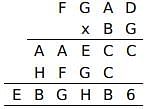
In the above multiplication, A, B, C, D, E, F, G and H are the different digits of number such that none of them is divisible by 5.
If it is known that D is twice that of F, answer the following questions
Q. Which digit corresponds to the alphabet "G"?
Enter -1 if the answer can't be determined.
A well known FMCG company mainly deals in manufacturing and selling its product in 4 different sectors which are namely, Packaged Foods, Electronics, Garments and Home Appliances. The percentage contribution to the sales they had to the year 2018, 2019 and 2020 are given as follows
Sales

Furthermore, the profit % obtained by selling the items of a particular sector year on year is given as follows

Based on the above data, answer the following questions
Q. If it is known that the total cost incurred for producing Goods was the same for the year 2019 and 2020. Then which among the following is the highest?
A committee of 3 is to be selected out of a group of 8 persons, 3 CAs, 4 MBAs and 1 CA-cum-MBA. In how many ways can the committee selection takes place, such that there is at least one CA degree and one MBA degree held, by the committee members.
A market surveyor was tasked to get basic information on 5 panellists who were sitting in a row. The leftmost position was numbered 1 and the rightmost was numbered 5. The details required were name, native city, current city and the car they owned. To capture the details she made a table. There were 4 interns under her and she wanted the interns to get first-hand experience of market survey, hence she sent them to the sitting area to get the details required. The first intern only got the names of the panellist. The second intern got the native city and so on. After getting the information they were to come back and fill the table accordingly. After the table was filled, it looked as follows:

After the panellists left, the surveyor figured out that each of her interns messed up the information. Exactly 1 out of 5 pieces of information provided by them is correct and the rest are wrong.
Furthermore, the following things were known:
- Ram sits at an extreme end and owns Elantra
- Nobody lives in the same city as their native city.
- The interns got either Shyam or his car's position correct.
- Parul's native city is Chennai. Qureshi has only one neighbour and he is Shyam.
- The native city of the person who owns an Audi is not Delhi.
- Person who drives Charger is one place to the right of the person whose native is Goa.
- Person who lives in Goa and the person whose native is Goa are sitting at the maximum possible distance.
- Shyam is sitting at the 2^{nd}2nd place from the right.
- Person who drives Charger is 1 place left of the person who lives in Hyderabad.
Q. Who drives Dodge?
There is a large plot of land in the form of a trapezium. The owner of the land has planned to convert it into a botanical garden, with a non-uniform walking track along its perimeter as follows (all measurements are in metres):
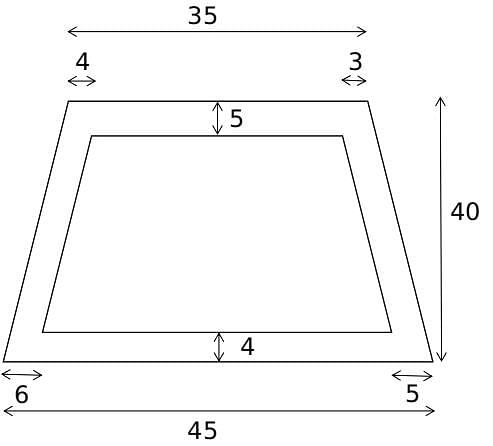
The portion of the land without the walking track is also in the form of a trapezium and has to be covered with artificial grass. The cost of laying the track is Rs. 35 per square metre and the cost of planting artificial grass is Rs. 400 per square metre. What is the total cost needed to lay the track and plant the artificial grass?
A quadratic equation f(x) = 0 has one positive and one negative root. If the graph of f(x) is shifted left along the x-axis to form f'(x) in such a way that the sum of roots of the quadratic equation f'(x) = 0 is zero, the distance between the minima of f(x) and f'(x) is 5 units. Which of the following is a possible sum of the roots of the equation f(x) = 0?
A cube is painted on five visible faces. Now it is cut in 64 identical smaller cubes by applying three equidistant cuts along each edge. Among 64 identical smaller cubes, how many cubes have no painted face?
A quadratic equation f(x) = 0 exists such that f(x) = 3x2 + 9x + 3. A second quadratic expression g(x) is formed by shifting f(x) towards the right along the x-axis by 5 units. What is the sum of the roots of equation g(x) = 0?
A town had a population of 140000. 1/7th of the people were diagnosed with a disease. The municipality had arranged for 2 variants of medicines A and B to treat all of them. A succeeded in healing 1/14th of patients it was given to, and B succeeded in healing 40% of people it was given to. Finally, a total of 3400 people recovered, with the help of these medicines. Find how many people were given Medicine A.
A and B have notes of Rs.500 and Rs.2000 denomination with them. The ratio of Rs. 500 notes with A and B respectively is 2:3, the ratio of Rs. 2000 notes with A and B respectively is 4:5. If the total amount with A is 24000 and the total amount with B is 32000, find the absolute difference between the number of Rs. 500 notes with A and Rs. 2000 notes with B.
If N is a 26 digit number, and M= log 10.
Let F(x) = logN/M, what will be the integral part of F(x)?
There is a right circular cylinder which has a base diameter of 16 units and a height of 6π units. An ant is at the circumference of the base of the cylinder and wants to reach the sugar cube which is placed at top-most point of diametrically opposite end from the ant. What is the minimum possible distance that ant has to travel?
How many ordered pairs (x,y) exist that satisfy the following inequality?
xy + 5x + 6y < 20
It has been given that x is a whole number and y is a natural number.
The following figure consists of a square, inside which there is a second square formed by joining the midpoints of the sides of the outer square. Inside the second square is inscribed a circle, and it continues in a similar manner. Find the ratio of the sum of areas of all the squares combined to the sum of the areas of the circles combined.
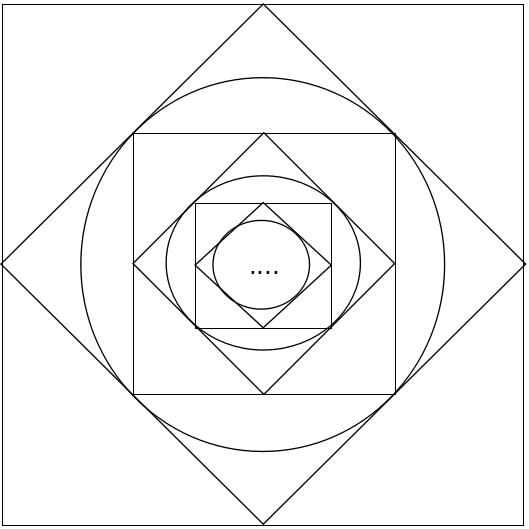








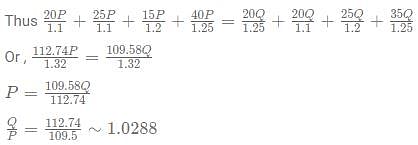










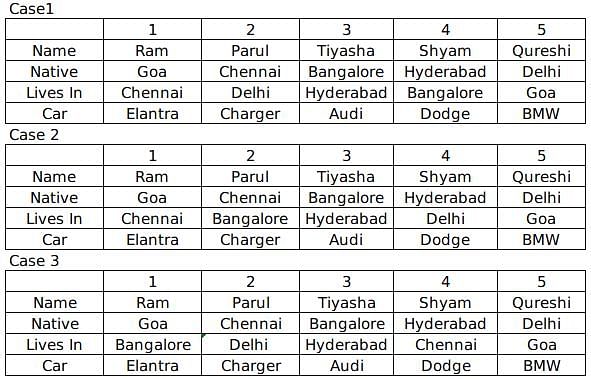




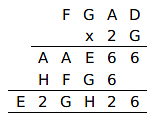
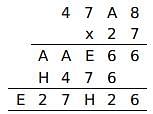
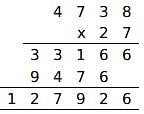








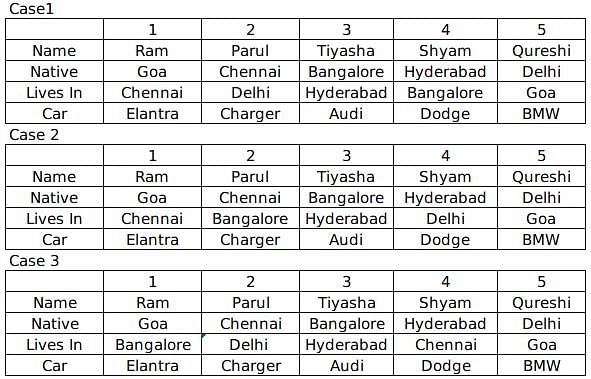
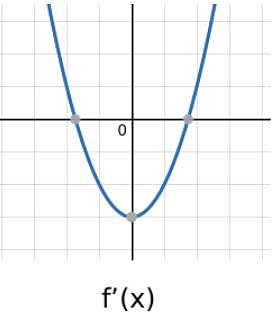
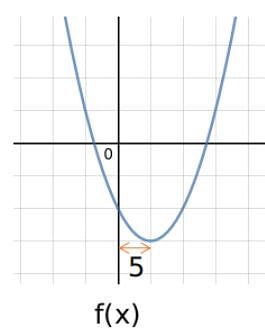

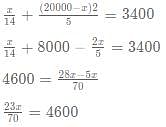

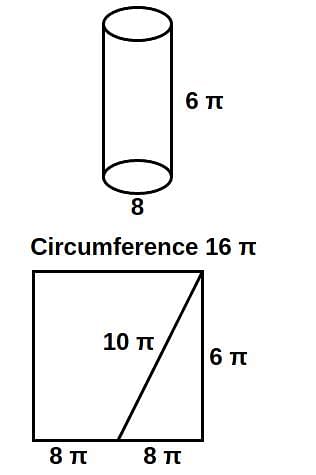


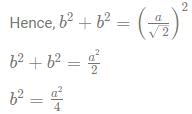


 ...
...